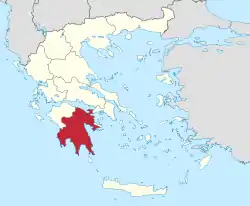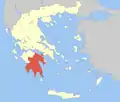Peloponnese (region)
The Peloponnese Region (Greek: Περιφέρεια Πελοποννήσου, romanized: Periféria Peloponnísou, [periˈferia pelopoˈnisu]) is a region in southern Greece. It borders Western Greece to the north and Attica to the north-east. The region has an area of about 15,490 square kilometres (5,980 square miles). It covers most of the Peloponnese peninsula, except for the northwestern subregions of Achaea and Elis which belong to Western Greece and a small portion of the Argolid peninsula that is part of Attica.
Peloponnese
Περιφέρεια Πελοποννήσου | |
|---|---|
 | |
| Coordinates: 37°24′N 22°18′E | |
| Country | |
| Decentralized Administration | Peloponnese, Western Greece and the Ionian |
| Capital | Tripoli |
| Largest city | Kalamata |
| Regional units | |
| Government | |
| • Regional governor | Panagiotis Nikas (New Democracy) |
| Area | |
| • Total | 15,489.96 km2 (5,980.71 sq mi) |
| Population (2011)[1] | |
| • Total | 577,903 |
| • Density | 37/km2 (97/sq mi) |
| Demonym(s) | Peloponnesian |
| Time zone | UTC+2 (EET) |
| • Summer (DST) | UTC+3 (EEST) |
| ISO 3166 code | GR-J |
| HDI (2018) | 0.837[2] very high · 10th |
| Website | ppel |
Administration
The Peloponnese Region was established in the 1987 administrative reform. With the 2011 Kallikratis plan, its powers and authority were redefined and extended. Along with the Western Greece and Ionian Islands regions, it is supervised by the Decentralized Administration of Peloponnese, Western Greece and the Ionian Islands based at Patras.
The region is based at Tripoli and is divided into five regional units (pre-Kallikratis prefectures),
which are further subdivided into 26 municipalities. The largest city of the region is Kalamata.
Major communities
- Kalamáta (Καλαμάτα) (population 2011: 54,567)
- Trípoli (Τρίπολη) (population 2011: 30,912)
- Kórinthos (Κόρινθος) (Corinth in English) (population 2011: 30,176)
- Árgos (Άργος) (population 2011: 22.209)
- Sparti (Σπάρτη) (population 2011: 17,408)
Economy
The Gross domestic product (GDP) of the region was 8.2 billion € in 2018, accounting for 4.5% of Greek economic output. GDP per capita adjusted for purchasing power was 17,400 € or 57% of the EU27 average in the same year. The GDP per employee was 68% of the EU average.[3]
References
- "Demographic and social characteristics of the Resident Population of Greece according to the 2011 Population - Housing Census revision of 20/3/2014" (PDF). Hellenic Statistical Authority. 12 September 2014. Archived from the original (PDF) on 8 September 2015.
- "Sub-national HDI - Area Database - Global Data Lab". hdi.globaldatalab.org. Retrieved 2018-09-13.
- "Regional GDP per capita ranged from 30% to 263% of the EU average in 2018". Eurostat.
External links
| Wikimedia Commons has media related to Peloponnese Region. |
- Official website
 (in Greek)
(in Greek)
